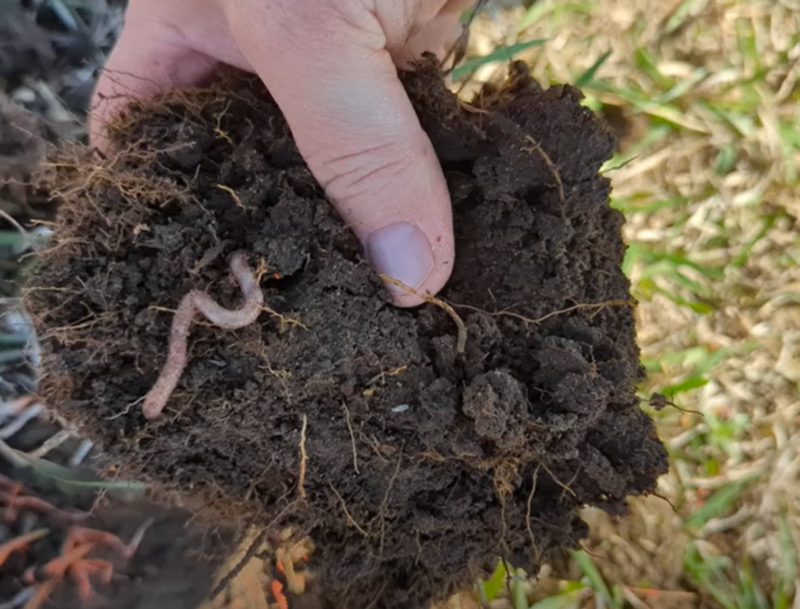This is a guest post (and a photo of regenerated soil) by David Ford.
My family and I are well into our first year of transition from living in the country and having a garden to actively building and transitioning to a homestead. This journey that we are on has taken a few twists and turns since 2008 when I built my wife her first garden and began to look for a simpler and more independent life. Currently, we are building an 800-square-foot home in Southeast Iowa on 15 acres of property that we own. Over the last seven years, we have used Regenerative, Organic, and Permaculture farming methods to rebuild a very nutrient-depleted soil.
What is Homesteading?
Have you heard of homesteading? It has become increasingly popular among Millennials and younger generations over the last decade. Many young families and individuals are now seeking out rural properties or homes with ample land to create their own homesteads. More and more people in even urban and suburban areas are now embracing homesteading, customizing it to fit their available space.
Recent generations have grown up with a lot of modern technology, which may inspire them to do things in unique ways. Additionally, there’s nothing like the rising prices of everyday items like eggs and milk to help inspire “what can we do differently” lines of thinking. Homesteading can provide opportunities to become more self-sufficient, save money, and even earn money from producing your own goods.
Homesteading has the added benefit of being eco-friendly as it promotes reducing waste and consumption while utilizing the resources already available. Many homesteaders proactively work towards waste reduction and efficient resource management right in their local communities, leading to less demand for long-haul transportation of goods, creating a virtuous local-focused circle.
The pandemic in the U.S. has significantly changed people’s attitudes and priorities. When the pandemic first hit and stay-at-home orders were put in place, many people began working from home. As a result, the concept of self-sufficiency became more appealing. With limited places to go and bare shelves at stores, self-sufficiency became a new interest for many Americans, perhaps for the first time.
How Large is a Homestead?
The main difference between a homestead and a farm is the size of the property and the amount of land needed. In states that offer federal benefits to homesteaders, a homestead must be less than 100 acres, while others define it as less than 200 acres. For federal purposes, land used for agriculture that is over 400 acres is considered a farm, while less than that is a homestead.
When it comes to providing food and income, homesteads and farms have different goals and methods. Homesteads use sustainable methods to provide for a family, while farms prioritize profits and efficiency as a business. The differences between the two will impact the size of the property and equipment needed. It’s important to consider these factors when deciding on the best agricultural choice for your needs and goals.
In general, farms tend to be bigger than homesteads because of the distinct operational and logistical factors that set them apart. However, there may be cases where farms, especially hobby farms, can have a size similar to that of a homestead. Nevertheless, they are not referred to as homesteads because their land usage differs from that of homesteads. Hobby farms are a fun side project that farm owners engage in for pleasure rather than relying on it for income or survival. While they may generate some income, it is not their main purpose. It is common for hobby farms to be located on small plots of land in urban or suburban areas where owners can grow vegetables and raise chickens.
Growing Against the Grain
The conventional or industrial agricultural system has numerous issues, such as unsustainable consumption of fossil fuel, water, and topsoil. This leads to various environmental problems, including air and water pollution, soil depletion, loss of biodiversity, and fish die-offs.
Our farm practices “Regenerative” farming, which differs from conventional farming because it integrates crops and livestock in circular ecosystems. Unlike conventional farming, where the two are kept separately, in regenerative farming animals feed the plants, and the plants feed the animals. This approach aims to enhance the ecological and social aspects of the farm and community. Additionally, organic agriculture typically prohibits the use of synthetic pesticides based on a set of rules. Permaculture involves the intentional design and maintenance of agriculturally productive ecosystems that emulate natural ecosystems’ diversity, stability, and resilience.
Healing the Land
Upon purchasing the land, we discovered that the soil was lifeless and dry, resembling the color of a Hershey bar. Ordinarily, the soil is teeming with life, consisting not only of minerals, air, and water but also of living organisms and their waste or remains.
Healthy soil is crucial for regenerative land stewardship, especially if you’re interested in permaculture or regenerative agriculture. The success of plant growth and a thriving ecosystem relies on soil that is abundant in nutrients, organic matter, and beneficial microorganisms. In essence, the foundation for everything is healthy soil.
When I first began working on my property, I discovered that my soil was shallow, compacted, alkaline, and often waterlogged for months. Despite this setback, I remained determined to achieve my goals of creating annual gardens, food forests, and perennial grasslands.
I came to the conclusion that I could either import new soil (which is not practical) or work on improving the soil I currently possessed. The latter option gave me an opportunity to revitalize the soil and gain knowledge on the subject of soil biology, so I embraced the challenge of building up my soil.
Soil Knowledge
Did you know that a teaspoonful of healthy soil contains more microorganisms than there are people in the world? It’s amazing to think about all the life that exists below the surface. But, if we want to replicate this biological richness in our food-growing systems, we must understand the ecosystem we’re trying to emulate. Whether it’s grassland or a forest, each has its own unique characteristics that we need to consider.
This means I needed to learn about “Ecological Succession,” which helps improve soil quality by bringing about changes in the types of plants and animals that live there over time. As the species change, they also impact the composition of the soil. In forest soils, fungi weigh more than bacteria, while the two are evenly distributed in grasslands. However, in agricultural soils that undergo regular tilling, the weight of fungi is less than that of bacteria. How is this information relevant? If you’re aiming to cultivate a healthy pasture, a self-fertilizing food forest, or a productive annual garden, it’s crucial to replicate the conditions where the plants naturally thrive.
More in Part 2…



